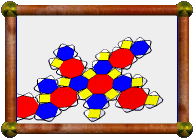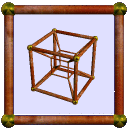 |
 |
 |
| Home > Research > Miller's Fifth Rule | |
| Prev (Unsupportable Finite Cells) | Next (Enumeration) |
Miller's Fifth Rule |
Miller's Rules were the rules used by Coxeter et al in their short book The Fifty-Nine Icosahedra. They were a set of criteria for deciding which combinations of stellation cells should be counted as different stellations. For example, they didn't want to include models that looked exactly the same, but had different shaped "bubbles" hidden inside them, so one rule prohibits models from containing internal gaps.
Great Stella supports Miller's Rules. While looking into them I had trouble understanding the fifth rule at first. Turns out everyone seems to have had trouble with it, because I now know of at least three different interpretations of it, including my own. I had found the fifth rule paraphrased on various web sites, and couldn't quite understand it, but as soon as I saw the original wording I understood. Here it is:
- (v) We exclude from consideration cases where the parts can be divided into two sets, each giving a solid with as much symmetry as the whole figure. But we allow the combination of an enantiomorphous pair having no common part (which actually occurs in just one case).
The confusion is over the exception at the end. All three interpretations lead to the same results for the 59 icosahedra, since only one extra model is included due to this exception, and this comes out the same with all three interpretations. For more complex cores though, interpretation makes a difference. So what did Miller really mean?
To explain the three interpretations, I will use the following hypothetical cell diagram. Here A is a reflexible cell, and B and C are chiral cells, followed by L for left or R for right.
CL CR
| |
| |
| |
BL BR
\ /
\ /
\ /
A
Let's also presume that all of these cells are still exposed in the final stellation (ie none are completely covered by cells in the next layer), so that we can ignore the 4th rule.
Valid stellations, ignoring the exception and enantiomorphic repeats, are: CL, BL, A, CL-BL, BL-A, CL-BL-A, BL-A-BR, CL-BL-A-BR, CL-BL-A-BR-CR.
- John Gingrich's interpretation: The exception allows single chiral
cell pairs as valid stellations, and that's all. So the exception gives us
these two extra stellations:
- CL-CR, BL-BR.
- Vince Matsko's interpretation: Any stellation may use both cells in a
chiral pair whenever either one may be used otherwise. So we get these
four extra stellations:
- CL-CR, BL-BR, CL-BL-CR, CL-BL-BR, CL-BL-CR-BR, CL-BL-A-CR.
- My interpretation: When a stellation is otherwise valid, and consists
of only chiral cells without their partners, then the combination of this
with its enantiomorph is a valid stellation. This gives these three extra
stellations:
- CL-CR, BL-BR, CL-BL-CR-BR.
I believe the purpose of the exception was to ensure that if a particular stellation is valid, then the combination with its enantiomorphic partner should also be valid.
Justification for my interpretation
"Parts", as used in the rules, refer exclusively to the small indivisible 2D parts in a stellation diagram. Some people have interpreted parts to mean 3D cells even, but the term clearly refers to 2D regions in the other rules.
Both of the first two interpretations assume that the "pair" referred to in the rule refers to a pair of parts, whereas I believe it must refer to a pair of sets of parts. This is because the first part of the rule already mentioned "two sets", and is still referring to those sets.
Furthermore, the rule specifies "having no common part", which would not make sense if we were talking about two single parts to start with (one part can never share a part in common with another part).
Finally, Peter Messer has an interesting way of reading the first sentence of the rule that removes the need for the second sentence altogether. If we interpret "as much symmetry as the whole figure" to include reflective symmetry, then the second sentence, by my interpretation, becomes redundant. The combination of any two enantiomorphs into a single reflexible stellation increases the symmetry. The new stellation cannot be "divided into two sets, each giving a solid with as much symmetry as the whole figure", since the sets would lack reflection symmetry. This reading gives us a way of understanding the "exception" without seeing it as something "exceptional". I'm not sure that they intended it this way, since the second sentence starts with the word "But", implying that it is indeed something not already covered, but I do think this reading sheds some light on the spirit of the exception. Or maybe it was intended this way all along and the second sentence is simply intended to clarify the situation involving reflection.
The final enumeration
John Gingrich was the first person to enumerate the number of stellations of the rhombic triacontahedron (RTC) using Miller's Rules, using his interpretation of the fifth rule. I have had correspondance with John for some time now, and he is willing to accept that my interpretation might be right (although he doesn't sound 100% convinced!). Last I heard, Vince Matsko still didn't accept my interpretation.
John Gingrich's enumeration of the number of stellations of the RTC must be incremented by 34 if my interpretation is correct, from 358833072 to 358833106. So I believe the true number of stellation of the RTC, using Miller's rules, is 358833106.
I'll let Prof. Coxeter have the final word on the matter. John wrote to him about this and here is part of Coxeter's reply (Feb 24, 2001):
- "I can't remember what Miller intended, so I leave you to choose which interpretation seems to make more sense."
| Home > Research > Miller's Fifth Rule | |
| Prev (Unsupportable Finite Cells) | Next (Enumeration) |
|
|
|
See all my products at: http://www.software3d.com Copyright © 2001-2024, Robert Webb |
|
|